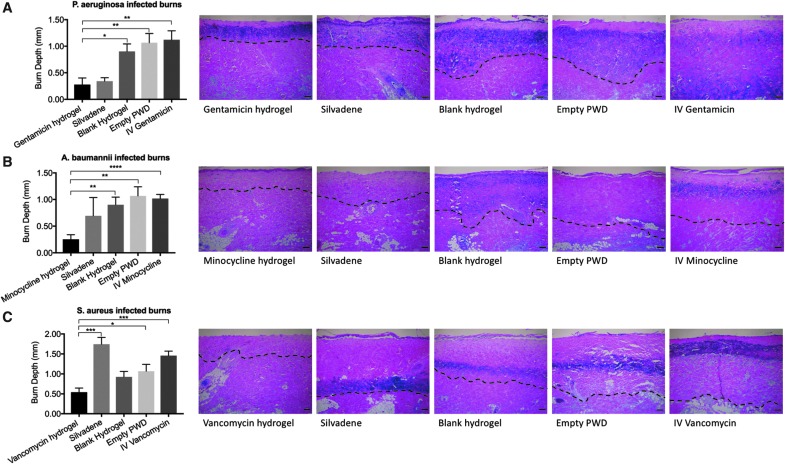Figure 5.
(A) Gentamicin: on day 7 post-burn, the results showed that topical gentamicin hydrogel (1000 × MIC) decreased the depth of tissue necrosis more efficiently in the P. aeruginosa-infected burns than blank hydrogel (p = 0.0135), empty PWD (p = 0.0065), and IV treatment (p = 0.0038) with gentamicin (p < 0.05). H&E-stained sections represent the burn wound after each treatment, and dashed lines are used to depict the depth of tissue necrosis. (B) Minocycline: minocycline alginate hydrogel also reduced the depth of tissue necrosis statistically significantly in comparison to controls (p < 0.05), excluding Silvadene cream (p-values: minocycline vs. blank hydrogel = 0.0049; minocycline vs. empty PWD = 0.0027; minocycline vs. IV minocycline = 0.0001). H&E-stained sections represent the burn wound after each treatment, and dashed lines are used to depict the depth of tissue necrosis. (C) Vancomycin: the results showed that in the S. aureus-infected deep partial-thickness burns topical vancomycin hydrogel (1000 × MIC) reduced the depth of tissue necrosis the most efficiently. The difference between vancomycin hydrogel and Silvadene cream (p = 0.0003), empty PWD (p = 0.0284), and IV vancomycin (p = 0.0002) was statistically significant. H&E-stained sections represent the burn wound after each treatment, and dashed lines are used to depict the depth of tissue necrosis. Comparison of groups was performed using t-test, and p-values <0.05 were considered statistically significant (*0.01 ≤ p < 0.05, **0.001 ≤ p < 0.01, ***0.0001 ≤ p < 0.001, p < 0.0001). H&E, hematoxylin and eosin; IV, intravenous; MIC, minimum inhibitory concentration.

